1948 to 1961
23 July 1945 LIFE magazine published drawings of a manned space station as envisioned by the German rocket scientists of Peenemunde.
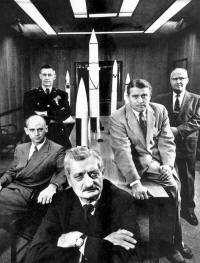
October 1948 Following an extensive survey of all available Ordnance installations, the Chief of Ordnance designated Redstone Arsenal the center for Ordnance rocket research and development
24 February 1949 BUMPER Round 5, fired at WSPG by a team of scientists under the direction of Dr. Wernher von Braun, was the first penetration of outer space by a U.S. missile.

1 June 1949 Redstone Arsenal was officially reactivated as the site of the Ordnance Rocket Center.
28 October 1949 The Secretary of the Army approved the transfer of the Ordnance Research and Development Division Sub-Office (Rocket) at Fort Bliss, Texas, to Redstone Arsenal. Among those transferred were Dr. Wernher von Braun and his team of German scientists and technicians, who had come to the United States under Operation Paperclip during 1945 and 1946.
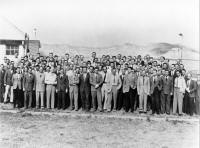
15 April 1950 With the arrival of the Fort Bliss group, Redstone Arsenal officially entered the missile era, and 1 year later assumed responsibility for the national procurement and field service missions. In addition to basic and applied research, development, and testing of free rockets, solid propellants, jatos, and related items, the arsenal was charged with research and development (R&D) of guided missiles.
24 July 1950 The first Army missile was launched from Cape Canaveral, Florida. BUMPER Round 8 attained a horizontal distance of 25 miles. The first-stage V-2 climbed 10 miles, successfully separating from the second-stage WAC CORPORAL, which traveled another 15 miles.
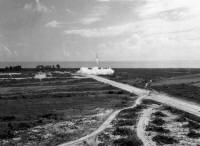
1 April 1952 The OCO disapproved Redstone Arsenal's proposed development plan for what would become the REDSTONE missile. The arsenal had intended to implement the manufacturing program for these missiles by creating an assembly line in its own development shops. The OCO, however, required that a prime contractor handle the development effort. Nevertheless, delays in acquiring production facilities for the contractor caused the arsenal to fabricate and assemble the first 12 REDSTONE missiles along with missiles 18 through 29.
15 September 1954 The first true engineered thesis for a minimum satellite vehicle using existing Army Ordnance Corps hardware was published. Written by Dr. Wernher von Braun, the thesis proposed using the REDSTONE missile as the main booster of a four-stage rocket for launching artificial satellites. The plan was later expanded into a joint Army-Navy proposal called Project ORBITER.
However, the Army's official role in the U.S. space satellite program was delayed after higher authorities elected in 1955 to pursue Project VANGUARD, which was based on the Navy's VIKING missile.
11 November 1954 Thirty-nine of Redstone's German-born scientists, along with the wives of two of the Operation Paperclip group, were sworn in as U.S. citizens. This event had a favorable impact on the arsenal's overall public relations image because it eliminated the stigma of "aliens" working on highly classified missions for U.S. defense.
14 April 1955 In an unprecedented ceremony held at Huntsville High School, 103 German-born scientists, technicians, and members of their families became American citizens. Among those taking the oath of citizenship was Dr. Wernher von Braun.
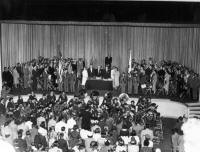
July 1955 President Dwight D. Eisenhower announced that the United States would undertake the construction of man-made satellites to travel "at incredible speeds around the Earth, 200 or 300 miles above its surface."
7 July 1955 Professor Hermann Oberth, an internationally known authority on space-flight rocketry, arrived for duty at Redstone Arsenal.
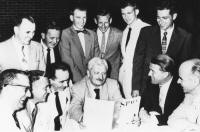
19 January 1956 The Chief of Ordnance issued an order assigning ABMA responsibility for the REDSTONE missile and Intermediate Range Ballistic Missile (IRBM) programs.
1 February 1956 Effective this date, ABMA was officially activated as a Class II activity under the jurisdiction of the Chief of Ordnance. ABMA's existence began with a purely military mission: to field the Army's first IRBM. The Army satellite program for which ABMA was best known was executed under special orders and was not actually assigned as a mission of this agency.
23 April 1956 The Army informed the Office of the Secretary of Defense (OSD) that a JUPITER missile could be fired in an effort to orbit a small satellite in January 57.
15 May 1956 The OSD's Special Assistant for Guided Missiles disapproved ABMA's request that the JUPITER C reentry test vehicle be used as an alternate to the VANGUARD vehicle.
22 May 1956 ABMA was informed of a decision by the Office of the Assistant Secretary of Defense that no plans or preparations should be initiated for using JUPITER or REDSTONE missiles as launch vehicles for orbiting a satellite.
20 September 1956 JUPITER C RS-27 flew 3,355 miles; attained an altitude of 682 miles; and achieved a velocity of Mach 18, enough to have put its fourth stage into orbit if permission had been granted to do so.
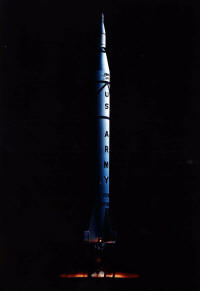
7 May 1957 The Army Chief of R&D reiterated that no plan existed for ABMA's backup of VANGUARD.
8 May 1957 It was announced that Professor Hermann Oberth, internationally known rocket and space flight research pioneer, planned to return to Germany later this year.
15 May 1957 JUPITER C Missile RS-34 was fired to test thermal behavior of a scaled-down version of the JUPITER nose cone during reentry. The nose cone was not recovered; however, instrument contact with the cone through reentry indicated that the ablative-type heat protection for warheads was successful.
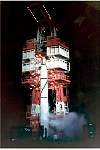
8 August 1957 JUPITER C Missile RS-40, a modified REDSTONE, was successfully launched. Its nose cone was the first to be recovered from outer space. It also carried the first mail ever delivered over IRBM range.
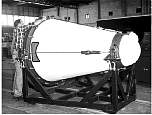
4 October 57 The Soviet Union launched SPUTNIK I, the first man-made earth satellite. It remained in orbit until 4 January 58.
3 November 57 The Soviet Union launched the world's second man-made satellite, SPUTNIK II. It remained in orbit until 13 April 58.
7 November 57 In a major televised address on science and security, President Eisenhower announced that Army scientists had successfully solved the problem of ballistic missile reentry. Shown as part of the broadcast was the JUPITER C nose cone recovered on 8 August 57.

8 November 57 The Secretary of Defense ordered ABMA to prepare a JUPITER C missile to launch a satellite as part of the International Geophysical Year (IGY) program. After the Soviet launch of SPUTNIK I on 4 October 57, the Secretary of the Army had submitted a proposal for a satellite using the JUPITER C missile, which the Army believed it could launch sooner than Project VANGUARD, the satellite program on which the United States had previously relied.
22 November 57 The OSD Director of Guided Missiles instructed the Army to launch two JUPITER C satellites to carry the cosmic radiation package prepared by Dr. James Van Allen of the University of Iowa.
December 57 ABMA submitted to DOD a "Proposal for a National Integrated Missile and Space Vehicle Development Program." This historic document suggested the need for a booster of 1.5 million pounds thrust.
31 January 58 JUPITER C Missile RS-29 successfully placed EXPLORER I, the first U.S. satellite, into orbit around the earth. The Navy did not successfully launch a VANGUARD satellite until 17 March 58. The EXPLORER I reentered the earth's atmosphere on 31 March 70.
ee the special EXPLORER I section
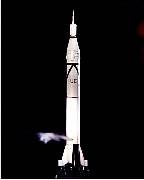
27 March 58 The Secretary of Defense assigned ABMA the mission of launching two lunar probes.
2 April 58 President Eisenhower recommended to Congress that a civilian agency be established to direct nonmilitary space activities.
18 May 58 JUPITER Missile AM-5, carrying the United States' first tactical type reentry nose cone, was fired from Cape Canaveral. This was also the first flight test for first and second stage separation. In less than 5 hours the nose cone was retrieved, marking the world's first recovery of an IRBM nose cone.
17 July 58 JUPITER Missile AM-6B was fired from Cape Canaveral, Florida. This was the first flight test of the complete inertial guidance system. The missile impacted on the predicted target, and its nose cone was successfully recovered less than 2 hours after liftoff.
29 July 58 President Eisenhower signed the National Aeronautics and Space Act of 1958, creating the National Aeronautics and Space Administration (NASA).
23 September 58 After AOMC and ARPA signed a memorandum of understanding on this date, the SATURN program began at ABMA under Army management. SATURN design studies were authorized to proceed at RSA for development of a 1.5-million pound thrust, clustered engine first stage.
1 October 58 This was NASA's first official day. By executive order of President Eisenhower, DOD responsibilities for the remaining U.S.-IGY satellite and space probe projects were transferred to the new civilian agency on 21 October.
3 December 58 President Eisenhower approved the transfer of JPL from AOMC to NASA. The Army and the civilian agency reached an agreement whereby AOMC and its subordinate organizations would be responsive to NASA requirements. Under existing contracts with JPL, the Army was allowed to continue certain specific military projects through 1959. These programs included the SERGEANT missile effort, special intelligence investigations, secure communications research, and aerodynamic testing and research.
6 December 58 The Army's first lunar attempt--PIONEER III--was launched on this date and went 66,654 miles toward the moon. Although it failed as a lunar probe, PIONEER III was considered to be a scientific success because it provided excellent data on radiation intensities as far out as 65,000 miles. It also proved that there were two distinct belts of very intense radiation. In addition, the launch was a successful test of the first four-stage JUNO II vehicle (modified JUPITER Missile 11).
13 December 58 JUPITER Missile AM-13 was fired, marking the first successful flight of a JUPITER IRBM incorporating the tactical ballistic shell configuration. Also significant was the fact that the missile carried a squirrel monkey named Gordo over IRBM distance, contributing highly useful data for Army and Navy medical research into space flights. Even though Gordo made the flight with no known adverse affects, the monkey could not be recovered because the nose cone's flotation device failed.
8 January 59 NASA assigned ABMA the mission to develop eight REDSTONE-type vehicles for use in the MERCURY manned satellite program.
3 March 59 PIONEER IV, the second Army vehicle to carry a NASA lunar probe experiment, was launched at AMR at 0011 hours Eastern Standard Time (EST). A joint ABMA/JPL project under the direction of NASA, it achieved a velocity in excess of 24,560 miles per hour; passed within about 36,000 miles of the moon; and traveled on to become the first U.S. satellite in permanent orbit around the sun. Radio contact with PIONEER IV was maintained to a record distance of 406,620 miles.
May 59 The Army completed a four-volume study on its proposed Project HORIZON, which detailed all aspects of a national program to establish a manned outpost on the moon's surface by 1966.
28 May 59 The flight of monkeys Able (an American-born rhesus monkey supplied by the Army) and Baker (a South American squirrel monkey furnished by the Navy) marked the first successful recovery of living creatures after their return to earth from outer space. The monkeys rode in the nose cone of JUPITER Missile AM-18 to an altitude of 300 miles and a distance of 1,500 miles, successfully withstanding 38 times the normal pull of gravity and a weightless period of about 9 minutes. Their survival of speeds over 10,000 miles per hour was the first step toward putting a man into space.
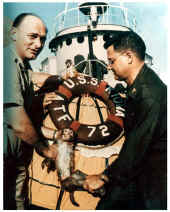
23 July 59 ARPA representatives visited ABMA beginning this date to discuss studies of a Maneuverable Recoverable Space Vehicle (MRSV) along three general lines of investigation: missions, systems, and components.
13 October 59 ABMA launched JUNO II Vehicle AM-19A, which successfully placed EXPLORER VII into orbit. The fourth satellite launched by the Army as well as the last of the U.S.-IGY satellites, EXPLORER VII contained seven experiments designed to extend the knowledge of outer space, particularly of cosmic radiation. According to the U.S. Weather Bureau Chief, the satellite also opened a new era in global meteorology.
2 November 59 President Eisenhower announced his intention to transfer the SATURN program to NASA.
7 January 60 The first MERCURY-REDSTONE booster engine was successfully fired.
29 April 60 ABMA conducted the first static firing of all eight SATURN booster engines. The successful test lasted for 8.07 seconds.
1 July 60 Effective this date, AOMC/ABMA lost all of its space-related missions, along with about 4,000 civilian employees and $100 million worth of buildings and equipment at RSA and Cape Canaveral. Responsibility for both people and property was assumed by NASA's George C. Marshall Space Flight Center, which officially opened at Redstone Arsenal on this same date.
8 September 60 President Eisenhower officially dedicated NASA's George C. Marshall Space Flight Center at Redstone Arsenal.
31 January 61 The second MERCURY-REDSTONE (MR-2) test flight carried a chimpanzee named Ham into space. This suborbital mission helped prove the system's operational capabilities in a space environment. Ham survived the flight safely.
5 May 61 MERCURY-REDSTONE 3 (MR-3) carried CDR Alan B. Shepard, Jr. on his historic suborbital flight.
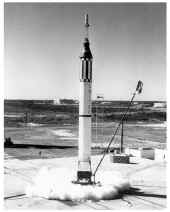
June 61 Tests on the Small Rocket Lift Device (Jump Belt) under Phase I, were completed during this month. It was concluded that the system design was safe and reliable enough to proceed with manned tethered and free-flight testing. Also known as the "Jet Vest," design fabrication and static testing of the device was conducted under contract between the U.S. Army Transportation Research Command and Bell Aerosystems Company.
21 July 61 The last MERCURY-REDSTONE flight carried CPT Virgil I. Grissom to a peak altitude of 118 miles and safely landed him 303 miles downrange.
